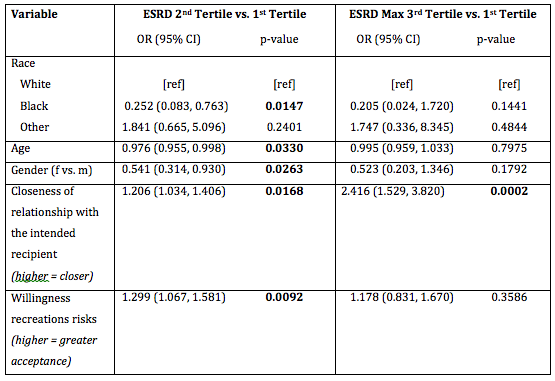How Potential Living Kidney Donors (LKDs) View ESRD Risk: A Multi-Center Study.
C. Thiessen,1 G. Gannon,1 D. Gray,2 K. Kennedy,3 D. Dobosz,1 S. Li,1 K. Yu,1 A. Mussell,2 E. Gordon,3 P. Reese,2 S. Kulkarni.1
1Yale U, New Haven
2U Pennsylvania, Philadelphia
3Northwestern U, Chicago
Meeting: 2017 American Transplant Congress
Abstract number: D242
Keywords: Donation, Ethics, Kidney transplantation, Psychosocial
Session Information
Session Name: Poster Session D: Living Donor Kidney Transplant II
Session Type: Poster Session
Date: Tuesday, May 2, 2017
Session Time: 6:00pm-7:00pm
 Presentation Time: 6:00pm-7:00pm
Presentation Time: 6:00pm-7:00pm
Location: Hall D1
Purpose
To determine how kidney donors view ESRD risk at initial donor evaluation.
Methods
We conducted a longitudinal, prospective study of LKDs at three centers and report results of LKDs' risk assessment at initial evaluation. LKDs received a novel visual aid representing the probability of post-donation ESRD and filled in a blank diagram to convey the highest chance of ESRD that they were willing to accept (WTA). Participants completed surveys to assess: demographics, relational closeness with the recipient (RCR), health, and risk tolerance. Multivariable multinomial regression assessed correlations between participant characteristics and WTA ESRD. Open-ended verbal probes explored reasons for WTA ESRD; responses from a random subset of 100 participants were analyzed with inductive qualitative coding.
Results
307 LKDs participated (response rate 85%); 14% planned to donate via paired exchange.
Mean WTA ESRD was 20% (range 0.01-100%); 9% accepted a 100% risk.
In multivariate analysis, being black, older, and female was associated with decreased WTA a moderate chance of ESRD (figure 1). Increased RCR and greater acceptance of recreational risks was correlated with WTA a moderate chance of ESRD. However, only RCR was associated with accepting the highest ESRD risks. Direct and exchange donors had similar WTA ESRD. 30% of participants reporting anchoring their maximal WTA ESRD to the data provided about actual risks. Common reasons for high WTA ESRD were: RCR (15%), “acceptability” of the risk level (12%), the benefit to the recipient outweighed the risk to the donor (12%), and donors received UNOS waitlist priority if they developed ESRD (8%).
30% of participants reporting anchoring their maximal WTA ESRD to the data provided about actual risks. Common reasons for high WTA ESRD were: RCR (15%), “acceptability” of the risk level (12%), the benefit to the recipient outweighed the risk to the donor (12%), and donors received UNOS waitlist priority if they developed ESRD (8%).
Conclusions
Our results enhance the transplant community's understandings of LKD risk acceptance and reasons for donation. Our interactive instrument provides an educational tool for LKDs to weigh the risk of donation. It also offers transplant professionals an objective method to determine how LKDs view risk, which can be used to provide greater personalized donor care by understanding each donor's risk tolerance and motivation.
CITATION INFORMATION: Thiessen C, Gannon G, Gray D, Kennedy K, Dobosz D, Li S, Yu K, Mussell A, Gordon E, Reese P, Kulkarni S. How Potential Living Kidney Donors (LKDs) View ESRD Risk: A Multi-Center Study. Am J Transplant. 2017;17 (suppl 3).
To cite this abstract in AMA style:
Thiessen C, Gannon G, Gray D, Kennedy K, Dobosz D, Li S, Yu K, Mussell A, Gordon E, Reese P, Kulkarni S. How Potential Living Kidney Donors (LKDs) View ESRD Risk: A Multi-Center Study. [abstract]. Am J Transplant. 2017; 17 (suppl 3). https://atcmeetingabstracts.com/abstract/how-potential-living-kidney-donors-lkds-view-esrd-risk-a-multi-center-study/. Accessed December 15, 2025.« Back to 2017 American Transplant Congress
